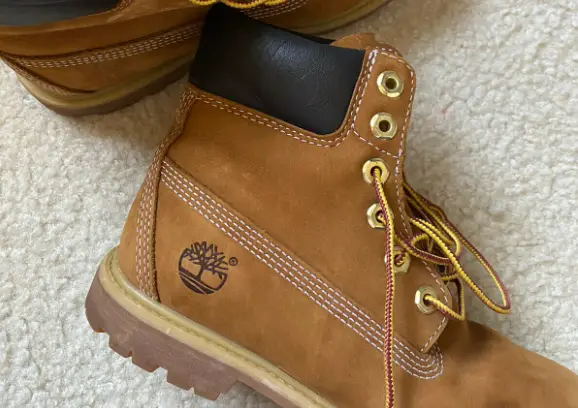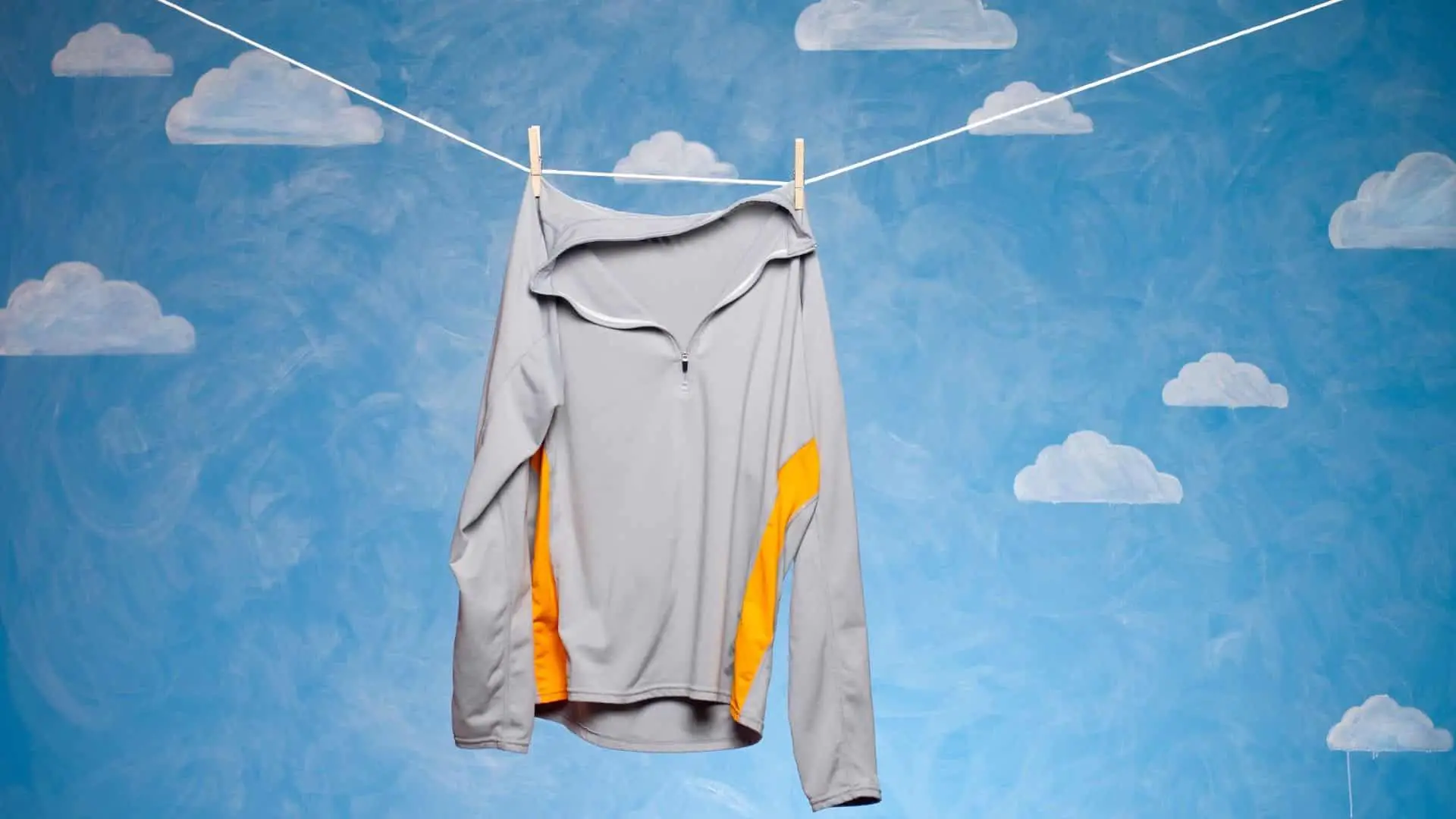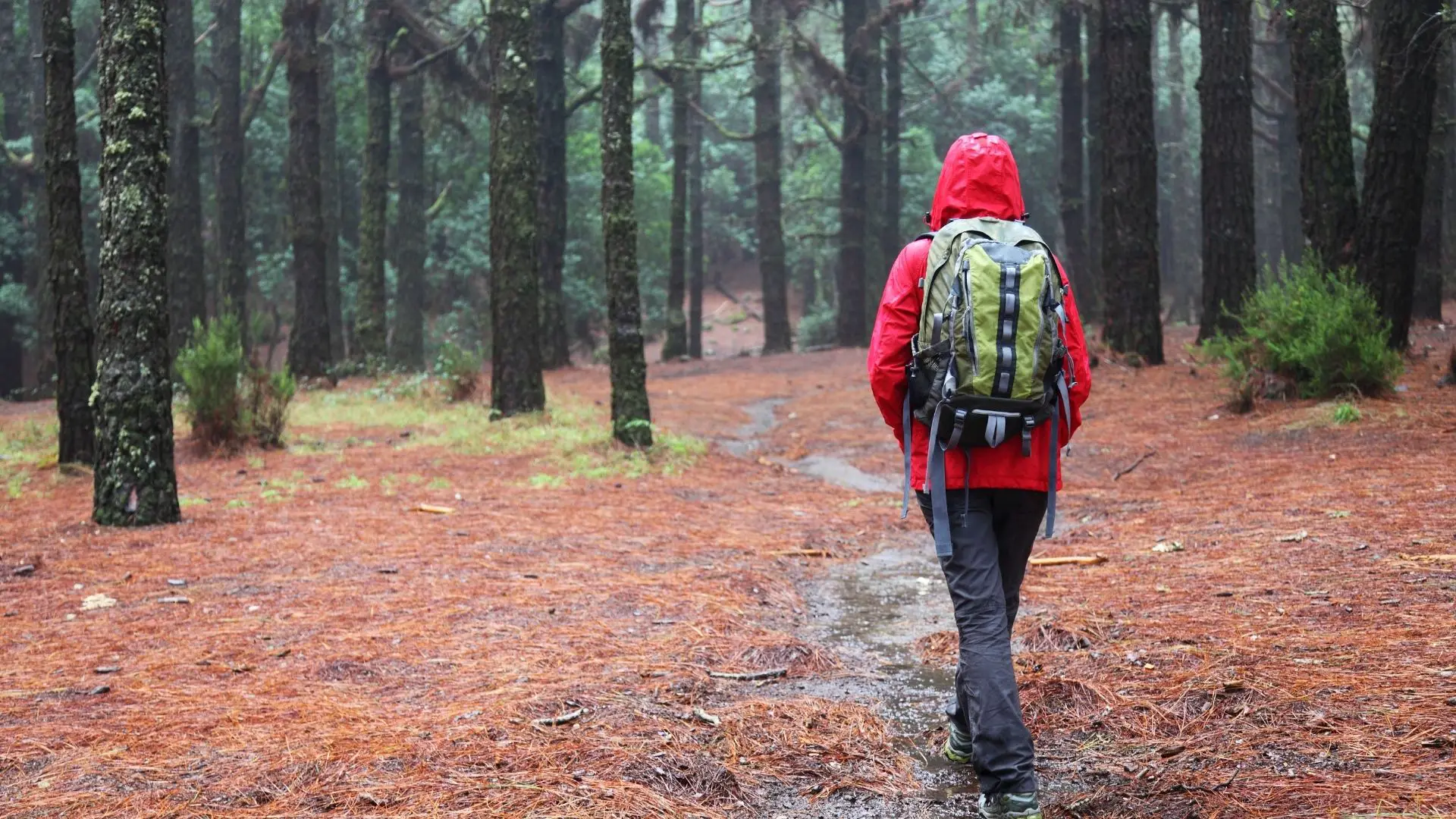Throughout the years, I’ve heard the same question asked over and over again. Newbie hikers looking to step up their game ask the question: Do I Need Hiking Boots? Is a pair of burly boots really necessary to hike through the woods or go backpacking?
You don’t need to wear heavy duty hiking boots. I recommend buying a pair of trail runners instead, but any pair of athletic shoes will work. The only time I recommend hiking boots is in rough terrain and cold weather. The added stability helps reduce ankle injuries and waterproofing/insulation will help in the cold.
The average hiker doesn’t need to waste their money on dedicated hiking boots or trail runners. A pair of comfortable running shoes is all you really need on smooth trails and easy terrain. Dedicated hiking shoes only start to get necessary on muddy trails and long backpacking trips. You don’t want your running shoes to fall apart 20 miles deep into the woods and days away from the trailhead.
Keep reading to learn a few of the differences between hiking boots, trail runners and regular running shoes. I bet you’ll think about switching over to trail runners before your next long backpacking trip.
Table Of Contents
Why Wouldn’t I Want To Wear Hiking Boots?
There are a bunch of reasons why people would want to ditch their hiking boots, but it usually boils down to 4 simple facts. Hiking boots can be expensive, they’re heavy, take forever to dry, and tend to cause blisters and chafing.
- Expensive: Hiking boots tend to fall into the $100-200 range. It doesn’t make sense to buy hiking boots if you’re only going on short 2-3 hour hikes after work. You should be able to get by with regular running shoes on short hikes through well manicured trails.
- Heavy: There’s no comparing the weight of hiking boots to trail runners. My trail runners are 20% of the weight of my hiking boots. The added weight of boots can really wear you out over a long backpacking trip or day hike.
- Blisters and Chafing: Boots are less flexible than traditional running shoes, have poor ventilation, and waterproofing that traps in sweat and water. That’s a recipe for blisters and chafing. Make sure you wear a pair of merino wool socks to prevent blisters if you choose to wear hiking boots.
- Take Forever To Dry: Hiking boots are designed to keep out water. That’s great in ideal conditions, but waterproof shoes will also traps in sweat and moisture. You will be absolutely screwed at the first stream crossing or in particularly rainy weather. Your boots will likely take days to dry leading to blisters and potentially swamp foot.
Do I Need Hiking Boots? Or Can I Switch To Regular Shoes?

From an early age, it was drilled into my head that I need to hike in a sturdy pair of high ankle hiking boots. I was told that your boots need to be tough, with high ankle support, and protection from the water. Forget about all that nonsense! Everything that was taught to you about hiking shoes is wrong!
Do I need hiking boots or dedicated hiking shoes? You DO NOT need to wear hiking boots. Honestly, I would go the complete opposite direction and recommend you avoid hiking boots in 99% of situations. There are better shoe options available that are far more comfortable. So what should I wear instead of hiking boots?
Most people prefer trail runners over hiking boots. I was amazed the first time I went backpacking with trail runners. It was like a literal weight was lifted off my feet. They’re a fraction (like 25%) of my hiking boots weight. I was almost mad after trying my Solomon Trail Runners for the first time. I couldn’t believe I had been hiking in boots for so long.
Trail runners would be my #1 choice, but they can be seriously expensive. In most situations, you can substitute trail runners with a regular pair of running shoes. Durability can be a concern on long backpacking trips, but you can get by with duct tape in a pinch. Don’t ask me how I know that!
There are 3 major reasons why people shy away from trail runners. The mesh sides let water in on rainy hikes, there’s less ankle support, and they’ll wear out faster than boots. I can understand the ankle support and durability concerns, but waterproofing isn’t a problem.
Trail runners are designed to get wet and dry fast. Just make sure you buy a good pair of merino wool hiking socks (my favorite). Merino wool socks are comfortable when wet and dry extremely fast. You won’t have to worry about blisters after switching over to merino wool. You’d be surprised that you can wear wool socks all year round. Wool is warm in the winter and cool in the summer. Check out another one of my posts explaining why hiking socks are worth buying for more information.
Hiking Boots vs Trail Runners
So are there any benefits to wearing hiking boots? Why are they still on the market if trail runners are so much better? I think they’re crazy, but some people actually prefer hiking boots. Personally I think the added weight on your feet outweighs any potential benefits, but they can be fine on short hikes in inclement weather. The table below will explain a few of the differences between boots and trail runners.
| Hiking Boot: Advantages | Trail Runner: Advantages |
|---|---|
| Added Stability: It’s hard to describe the added stability you get from hiking boots. The tight lacing and high sidewalls make your feet feel planted on the ground. This is great in technical terrain when slipping could lead to serious injury. | No Break In Period: Hiking boots can take weeks to break in and you still might end up with blisters and chafing issues. Trail runners are comfortable right out of the box. |
| Extreme durability: It will take a long time to wear through hiking boots (1000s of miles). Dry rot is your worst enemy. | Breathability: There are 2 main advantages when it comes to breathability. Your feet will get less sweaty on dry days and shoes will dry faster in wet conditions. Plan on wearing merino wool socks so you’re comfortable in wet conditions. |
| Foot and ankle protection: There’s less chance of rolling your ankle in hiking boots. However, the high ankles and added sidewall thickness add weight to your boot. | Lightweight: I could easily run a 10k in my trail runners. The lightweight design allows you to keep a fast pace over a long distance. |
| Waterproofing: Waterproofing can be a good or bad thing. It’s nice for getting through puddles, but it will lead to sweating and blisters. Merino wool socks (my favorite) can help prevent blisters in wet conditions. | Dry Fast: Trail runners are designed to let water in and dry out fast so they take some getting used to. Always wear merino wool socks (my favorite) to prevent blisters and speed up drying times. |
| Warmer: Warmth is great on cold weather hikes, but leads to sweating and blisters in the summer. Waterproofing makes matters worse since there’s nowhere for the sweat to go. | Cool In Summer: The mesh sidewalls and lightweight design makes trail runners cool in the summer. You won’t have to worry about sweaty, worn down feet after a long hike. |
| All Around Traction: Good all around traction for every situation. You only need one pair of boots for everything. There’s less traction options for various terrain. | Traction Options: A wide range of traction options for any type of trail condition. I have a second pair of mud running shoes that have longer spikes for hiking mucky/muddy conditions. |
| Hiking Boot: Disadvantages | Trail Runner: Disadvantages |
|---|---|
| Heavy/Bulky: Hiking boots aren’t comfortable compared to traditional shoes. There’s an old saying “a pound on your feet equals five pounds on your back”. That’s not entirely accurate, but you’ll notice a huge difference on longer backpacking trips. | Less Durability: I’ve had the same pair of hiking boots for a decade and they’re still in decent shape. In that same timeframe I’ve went through 10 pairs of trail runners. Mesh uppers will not last as long as traditional leather hiking boots. |
| Need a Break In Period: I recommend wearing your hiking boots around the house for 2-3 weeks before stepping foot on the trail. | Less Support: Stick to hiking boots if you have ankle issues. Less support and stability can lead to injury. |
People Thru Hike The Appalachian Trail Barefoot
There was one major thing that changed my mind about hiking boots. My friends father was talking to me about his most recent thru-hike of the Appalachian trail. All the usual conversations came up about drop-off points, pack weight, etc, but then we started talking about trail footwear.
While it seems absolutely insane, a small percentage of people walk the Appalachian trail completely barefoot. Walking the trail is hard enough in shoes. I can’t imagine the calluses, scrapes, and blisters that would form over a 2,190 mile barefoot walk.
This newfound knowledge led me to a simple question. If there are people hiking long distances barefoot, then why the heck do I need sturdy hiking boots? Is ankle support really that important or would weight off my feet be better for reducing injury? I started hiking in trail runners and never looked back.
Trail Runners vs Regular Running Shoes
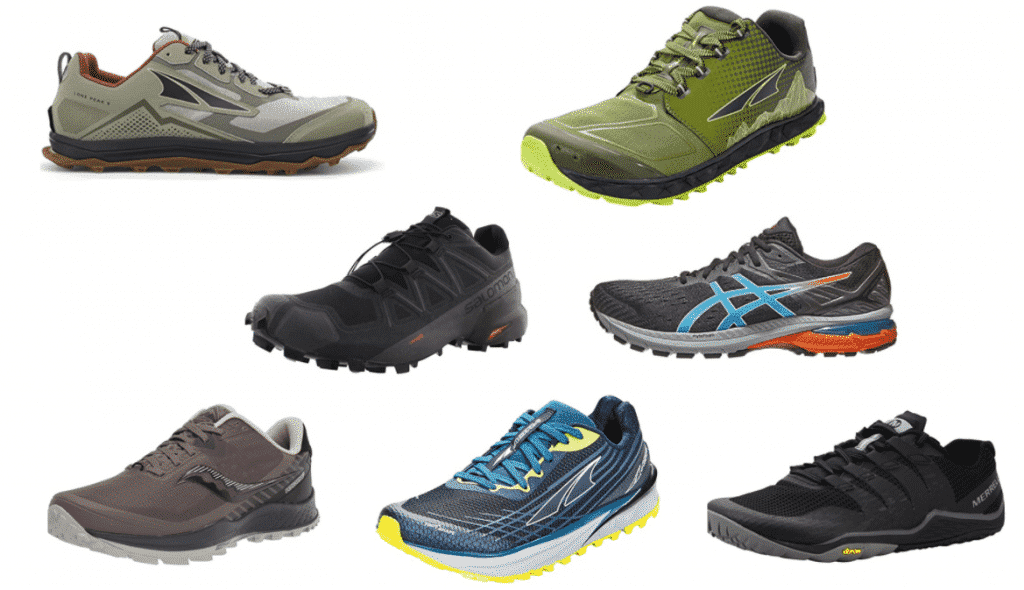
There are 2 major differences between trail runners and traditional running shoes. Trail runners are designed for long distances on difficult terrain. So the bottoms are designed to withstand varying trail conditions and won’t wear out over long hikes. They might not be as durable as boots, but they should last 1000’s of miles and a few years on the trail.
Trail runners will also have aggressive tread patterns making them better in difficult terrain. That’s not a big deal on dry flat ground, but it can be a major advantage on muddy/mucky ground. I’ve also noticed a huge difference when hiking through mountainous terrain. The added traction seems to take stress off my calves and ankles.
Wouldn’t Mesh Trail Runners Get Wet? How Can I Dry Out My Shoes?
Mesh trail runners will definitely get wet over a long backpacking trip, but that’s not a bad thing. They’re designed with mesh sides and drainage ports on the bottoms so they will dry out fast. My trail runners (these ones) dry out somewhere between 20 minutes and 2 hours depending on the weather.
It all depends on the weather and type of socks you’re wearing. On a warm day, I might sit and relax for a few minutes after a stream crossing. My trail runners take like 20 minutes to dry out when they’re off my feet. The key to speeding up the drying process is having the right pair of hiking socks.
Definitely Buy Merino Wool Hiking Socks
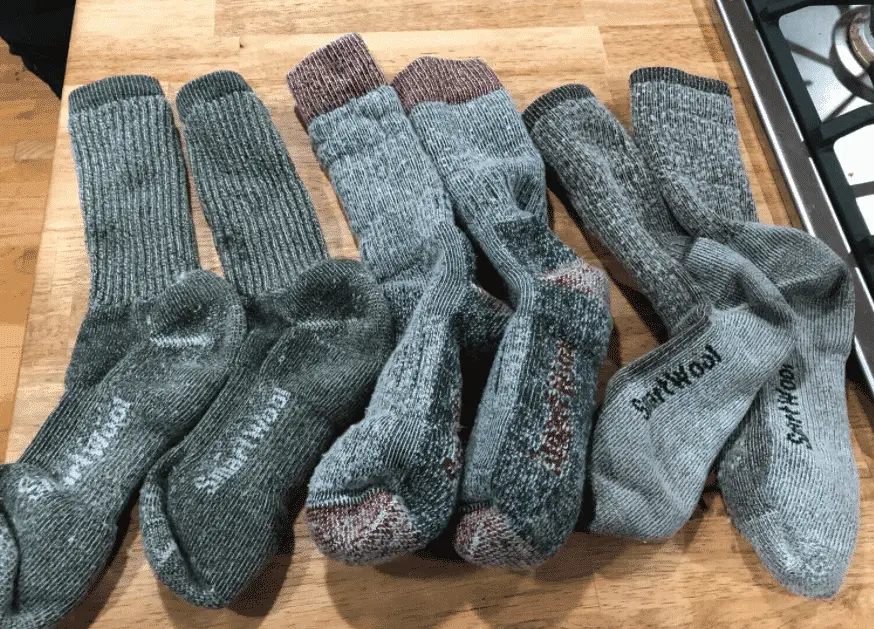
You really need to buy a pair of merino wool hiking socks if you plan on wearing trail runners. Merino wool socks dry fast and can absorb up to 30% of it’s weight in water without feeling wet. Plus they’re comfortable even when completely soaked. So you probably won’t feel the moisture even if the shoe is a little damp.
Personally, I always go with Smartwool Socks, because they’re ridiculously comfortable. Darn Tough is another option but they use a merino wool and synthetic blend. Using a blend makes the socks more durable, but you sacrifice the comfort of merino wool. The Smartwool Socks pictured above are like 10 years old and they’re still in great condition so I guess I’ll buy a few more pairs if they ever wear out.
Here are a few of the benefits to picking up merino wool hiking socks.
- Comfortable While Wet: You probably won’t believe me at first, but wool socks remain comfortable while wet. That’s why the stereotypical sailor outfit consists of a wool sweater. Wool can absorb up to 30% of its weight in water before it starts to feel wet. That’s a lot of sweat before you start feeling uncomfortable.
- Warm In Winter: Wool is the absolute king when it comes to winter insulation. Even the most expensive cotton/synthetic socks pale in comparison to a cheap pair of wool.
- Cool In Summer: This is the one that surprises most people. You wouldn’t think of wool as a summer clothing staple, but it really does keep you cool and dry in the summer.
- Moisture Wicking: Merino wool is both temperature regulating and moisture wicking. You can wear the same pair of socks all year long regardless of the weather.
- No More Blisters: Wool socks cut down on friction, moisture, and add padding. It doesn’t matter how far you hike. You should not get blisters with merino wool hiking socks.
- Extreme Durability: I’ve put my wool socks through the ultimate field test. They get worn around camp without shoes, hiked 15+ mile days, and done god knows what else. A $20 pair of hiking socks should last a decade.
- Smellproof: Wool is both breathable and has antimicrobial properties. Both of these factors will significantly cut down sweat and smell.
- Super Soft: There’s absolutely no itch in modern merino wool. I would say that it’s one step below cashmere with added durability.
- Lightweight: Merino wool is lightweight compared to cotton/synthetic socks. As an added bonus, you can wear the same pair of socks multiple days in a row saving pack weight.
- Doesn’t Stretch Or Sag: Merino wool has extremely durable fibers that shouldn’t stretch or sag. The natural elasticity of wool will either rip or return to its original shape. There’s no inbetween.
- Easy To Wash: This isn’t your grandmothers wool. Merino wool doesn’t have any kind of special washing instructions. My socks go right in with all my other clothes. I like to hang dry them to prevent shrinkage, but I’ve ran them through the drier without problems.
- Environmentally Friendly: merino wool is 100% sustainable since you don’t harm the sheep during the harvesting process. They automatically grow a new coat every year and it causes the sheep no pain.
When Are Hiking Boots Better?
Personally, I would only wear hiking boots in the winter or on extremely muddy trails. There’s no comparing the warmth of traditional leather hiking boots and trail runners. Trail runners are designed to allow water and air to get into your shoes. That’s the last thing you want in the winter.
Trail runners can definitely perform in the mud. You almost need the spiked if you’re trying to run through difficult muddy terrain. Those spiked studs are great if you’re running, but they’re not really necessary if you’re hiking at a slow pace. I would rather have slightly less traction and more ankle stability on muddy trails. It’s really a tradeoff, but I’ve never been injured on the trail, so I must be doing something right.
Ever try getting mud out of mesh? It’s a serious pain in the butt! Cleaning mud off trail runners is a serious challenge. I’ve found that hosing them off outside and using a toothbrush to work in the grooves is the easiest way to clean my shoes.
There Is a Compromise!
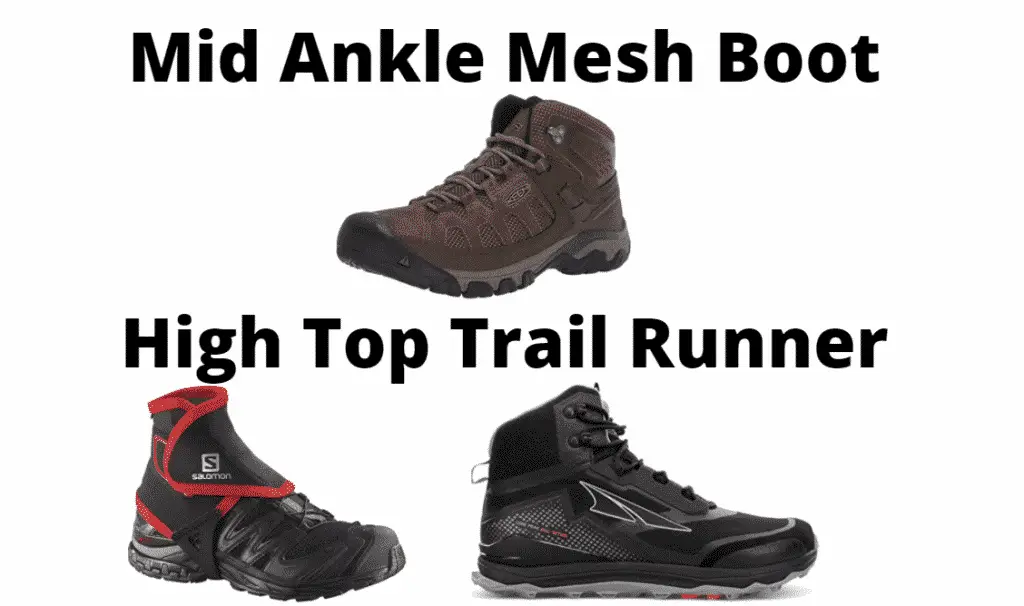
With 1000s of different hiking boots/shoes on the market, it can be hard to choose a single pair that’s good for everything. Trail runners are great in the summer when you’re looking for light breathable footwear, and boots are nice for difficult terrain wear ankle support is needed.
There is a solution for people that just can’t seem to make up their mind. Get a pair of lightweight day hiking boots with mesh uppers like the KEEN Mid Ankle Mesh Hiking Boot or High Ankle Trail Runners like Altra’s Lone Peak All Weather. Obviously, these shoes aren’t perfect, but they’re a good compromise.
Salomon’s Trail Gaiters are a hybrid option that can be added to any pair of trail runners. They strap down around your ankles providing support and cushioning from side impact. I like to use these when I’m running through rocks/brush to protect my ankles from impact. They’re almost like wearing shin pads in soccer or cross country.
Consider A Pair Military Combat Boots For Hiking
Most people are familiar with the typical standard issue combat boot that you see in the military, but what you don’t realize is there are 2 different styles of boots available. You have insulated cold weather boots, and the summer boots that most of us are familiar with.
Consider what the military uses their combat boots for. They’re designed to hike long miles in tough terrain with a heavy pack. Doesn’t that sound an awful lot like hiking and backpacking? It should, because there’s not much of a difference between hiking boots and combat boots.
The added ankle support increases the weight by a few oz, but everything else is the same. They’re actually far more durable than a typical hiking boot since they have to pass US Military Testing Standards.
I actually prefer my winter combat boots over every pair of insulated hiking boots I’ve ever owned. You may want to check out my other post on using military combat boots for hiking for more information. Or you can check out Belleville, Bates, and Mcrae combat boots if you’d like to buy a pair.
Personally, I like the Bellvilles and Bates boots, but the Mcraes are the most commonly issued boots so they tend to be a little bit cheaper. Just make sure you choose the right type of boot for the season you’ll be hiking. There are hot weather and cold weather insulated/waterproof boots so you don’t want make that mistake.

